高级计算机图形学ACG05
高级计算机图形学ACG00

高级计算机图形学Advanced Computer GraphicsCourse No. 04814560主讲教师:裴玉茹Instructor: Yuru PeiEmail: peiyuru@Department of Machine IntelligencePeking UniversityWelcome to Advanced Computer Graphics Introductions–Instructor: 裴玉茹•Office: Science Building 2, 2224#•Email: peiyuru@.cm•Office Phone: 62756657–TA:魏嘉•Email: weijia@About this courseTopicsAbout This CourseAdvanced Computer Graphics–Course NO. 04814560Webpage–/vision/Visual&Robot/people/pei%20yuru/acg09.htm 14 Lectures + 2 PresentationsTime and Place–Monday, 14:40-17:40–Teaching Building 2, 413About This Course Evaluation Method–Final Score = 80%A+20%B–A: Two class projects and written assignments•Presentation•Programming•Reading report–B :Final examination–Bonus☺PrerequisitesIntroduction to Computer Graphics–Familiar with concepts in ComputerGraphicsProgramming background in C/C++–OpenGL / Directx3DMathematics–Linear algebraReferencesAkenine-Moller and Haines, Real-time rendering (2/3 ed), AK PETERS, LTD.Alan Watt. 3D Computer Graphics, (3rd ed), Addison-Wesley, 1999.Kerlow, Isaac Victor, The art of 3D computer animation and effects(3rd ed),John Wiley, 2004.Donald Hearn,M.Pauline Baker,Computer Graphics with OpenGL,(3rd ed),Pearson,2004.James D. Foley, Andries van Dam, Steven K. Feiner, John F. Hughes, Computer Graphics: Principles and Practice in C, (2nd ed),Addison-Wesley Professional, 1995.Dave Shreiner, Mason Woo, Jackie Neider, Tom Davis,OpenGL Programming Guide: The Official Guide to Learning OpenGL®, Addison Wesley Professional.Course Goals Introduce current trends of computergraphics-Conference, JournalsThe state of art of computer graphics–Digital cartoon movies –Computer games3D DigitalCartoon Movie3D ComputerGameCGResearchCGConferenceCG JournalCGResearcherTrends of Computer Graphics Conference–ACM SIGGRAPH•International Conference on Computer Graphics andInteractive Techniques•30,000~40,000 participants, 20%, ToG–EuroGraphics•Annual Conference of the European Association forComputer Graphics•500~600, 20%, Computer Graphics Forum–PG•Pacific Conference on Computer Graphics and Applications •Approx. 400, the Visual Computer/ Computer GraphicsForumTrends of Computer GraphicsJournal–ACM ToG•Transactions on Graphics–IEEE Trans. VCG•Transactions on Visualization and Computer Graphics –IEEE Computer Graphics & Application–The Visual Computer–Computer Graphics Forum–Computer Animation and Virtual WorldsTrends of Computer Graphics ResearchersThe ACM SIGGRAPH Awards program–The Steven A. Coons Award–The Computer Graphics Achievement Award–The Significant New Researcher AwardLaboratory–Computer Graphics Group at Stanford University–Computer Graphics Lab at MIT–Computer Graphics Lab at ETH Zurich–MSRA–State Key Lab of CAD&CG at ZJU–...2008 Computer Graphics AchievementAward to Ken PerlinTwo-dimensional slice through 3D PerlinnoisePerlin noise rescaled and added into itself tocreate fractional Brownian motion.2007 Computer Graphics AchievementAward to Greg WardHigh Dynamic Range ImagingAcquisition, Display, Image-BasedLighting–a set of techniques that allows agreater dynamic range of exposures-the range of values between light andark areasThe intention of HDRIto accurately represent the wide range ofintensity levels found in real scenes ranging from directsunlight to shadows.2004 Computer Graphics Achievement Award to Hugues Hoppe Pioneering work on–Surface reconstruction–Progressive meshes–Geometry texturing and geometry images.PhD thesis “Surface reconstruction from unorganized points,”advised by TonyDeRoseHugues Hoppe, Tony DeRose, etc., PiecewiseSmooth Surface Reconstruction, in Siggraph942003 Computer Graphics Achievement Award to Peter Schröder Contributions to the newly emergingarea of 3D geometry processing–Form the basis of the research incomputer graphics and digitalgeometry processing–Subdivision surfaces–Multiresolution modelingD. Zorin, P. Schröder, W. Sweldens:Interactive multiresolution meshediting. In SIGGRAPH 97Like Teacher, Like Student2002 SIGGRAPH computer graphics achievement award to David B. Kirk Key technical role in bringing highperformance computer graphics systems tothe mass market–Offered z-buffering and shading infirmware–The Apollo DN1000VS, the firstworkstation to offer hardware texturemapping–Researching algorithms for ray tracingacceleration, object oriented raytracing, and global illuminationHe joined NVIDIA in 1996. There he drove development of the RIVA128, the RIVA TNT,the GeForce, the GeForce2, GeForce3, and GeForce42001 Computer Graphics Achievement Award to Andrew Witkin Pioneering work in bringing a physics basedapproach to computer graphicsWork on active contours (snakes)anddeformable models, variational modeling,scale-space filtering, space timeconstraints, and dynamic simulationPhD. at MIT in the Psychology department onthe perception of surface orientation fromtexture statisticsTechnique of Scale-Space Filtering–A classic in the multi-resolution signalanalysis literatureStuart Little Monsters Inc.First of this century's Computer Graphics Achievement Award to David Salesin Pioneering the field of non-photorealisticrendering and introducing it to theSIGGRAPH communityHis work on computer generated pen andink illustrations and subsequentlycomputer-generated watercolors areconsidered landmarks in this emergingfield.He then spent the year with photorealisticrendering at the Program of ComputerGraphics at Cornell University.He has worked at the Lucasfilm, Pixar.1999 Computer Graphics Achievement Award -Anthony D. DeRose Seminal work in making subdivisionsurfaces a practical geometricmodeling technique–Only two widely accepted geometricprimitives in computer graphics•Polygons and parametric patches–DeRose's work will surely add anotherprimitive to the geometric modeler'spantheon -subdivision surfaces.T. DeRose, M. Kass, T. Truong,Subdivision Surfaces in CharacterAnimation, in SIGGRAPH 98Course GoalsIntroduce current trends of computer graphics -Conference, Journals, Researchers The state of art of computer graphics –Digital cartoon movies–Computer games 3D DigitalCartoon Movie3D ComputerGame CG Research CG Conference CG Journal CGResearcherState of art of computer graphics Digital Cartoon MoviesPIXAR–1995 Toy Story–1998 A Bug's Life–1999 Toy Story 2–2001 Monsters, Inc.–2003 Finding Nemo–2005 The IncredibleDeamworks–2001Shrek–2004 Shrek 2–Shrek 3Have fun!☺Cartoon Movie3D ComputerGameState of art of computer graphics Digital Cartoon MoviesPIXAR–1995 Toy Story–1998 A Bug's Life–1999 Toy Story 2–2001 Monsters, Inc.–2003 Finding Nemo–2005 The IncrediblesDeamworks–2001Shrek–2004 Shrek 2–Shrek 3…Have fun!☺Cartoon Movie 3D ComputerGame长江七号Final FantasyOutlineThe graphics rendering pipelineTransformsVisual appearanceTexturingAdvanced lighting and shadingNon-photorealistic renderingImage-based renderingAcceleration algorithmsPipeline optimizationPolygonal techniquesCurves and curved surfaceIntersection test methodsCollision detectionReadings3D Mesh ProcessingParameterization3D Mesh Feature Description and Shape AnalysisTexture Mapping and Non-Photorealistic Rendering3D Animation3D Mesh ProcessingMesh Processing–Surface reconstruction from unorganized points [Hoppe94 ]–Progressive mesh [Hoppe96 ]–Terrain rendering [Hoppe04]P. Sander, J. Snyder, S. Gortler, H. Hoppe.Texturemapping progressive meshes. ACM SIGGRAPH 2001,409-416.H. Hoppe. Progressive meshes. ACM SIGGRAPH 1996,99-108.Hugues Hoppe, Tony DeRose, etc., Piecewise SmoothSurface Reconstruction, in Siggraph94F. Losasso, H. Hoppe. Geometry clipmaps: Terrainrendering using nested regular grids. SIGGRAPH 2004, 769-776.References3D Mesh ProcessingSubdivision surfaces–Subdivision surfaces used in CharacterAnimation [Derose98]Visualization of very large surface models–Streaming Meshes [Isenburg 05]–Out-of-core construction and accurate view-dependent visualization [Cignoni04]Super-Resolution of 3D Face [Pan06]Geri’s Game [Pixar]T. DeRose, M. Kass, and T. Truong. Subdivision Surfaces in Character Animation. In Proc. ACM SIGGRAPH 1998,Computer Graphics Proceedings, Annual Conference Series, pages 85-94. ACM Press / ACM SIGGRAPH, July 1998.M. Isenburg, P. Lindstrom, Streaming Meshes, Proceedingsof Visualization'05, pp. 231-238, October 2005.G. Pan, S. Han, Z. Wu, and Y. Wang , Super-Resolution of3D Face, ECCV06, 389-401, LNCS3952P. Cignoni, F. Ganovelli, E. Gobbetti, F. Marton, F. Ponchio,and R. Scopigno. Adaptive TetraPuzzles-Efficient Out-of-core Construction and Visualization of Gigantic PolygonalModels. ACM Transactions on Graphics, 23(3), pp. 796-803, Proc. SIGGRAPH 2004ReferencesParameterizationMRA (Multi-ResolutionAnalysis)–Multiresolution Analysis ofArbitrary Meshes[Eck95]MAPS: MultiresolutionAdaptive Parameterization of Surfaces [Lee98]Multiresolution Mesh Editing[zorin97]M. Eck, T. DeRose, T. Duchamp, H. Hoppe, M. Lounsbery,W. Stuetzle. Multiresolution analysis of arbitrary meshes.SIGGRAPH 1995, 173-182, 1995.A. Lee, W. Sweldens, P. Schrder, L. Cowsar and D. Dobkin.MAPS: Multiresolution Adaptive Parameterization ofSurfaces. Proceedings of SIGGRAPH 98. pp. 95-104, July1998D. Zorin, P. Schroder, and W. Sweldens. InteractiveMultiresolution Mesh Editing. In Proc. ACM SIGGRAPH1997, Computer Graphics Proceedings, pp. 259-268. 1997 ReferencesParameterization Normal Mesh [Guskov2000]Consistent MeshParameterizations[Praun2001] Displaced Subdivision Surfaces[Lee2000]I. Guskov, K. Vidimce, W. Sweldens, P. Schröder, Normal Meshes, Computer Graphics Proceedings (SIGGRAPH 2000), pp 95-102, 2000E. Praun, W. Sweldens and P. Schrder. Consistent Mesh Parameterizations. Proceedings of ACM SIGGRAPH 2001. pp. 179-184, 2001.A. Lee, H. Moreton, and H. Hoppe. Displacedsubdivision surfaces. In Proc. ACM SIGGRAPH 2000, 2000.ReferencesParameterizationCorrespondence establishment and applications Optical flow based methods–Creating Face Models [Blanz99]Reconstruction and parameterization from range scans[Allen 02]Deformation Transferring [Sumner 04]V. Blanz and T. Vetter. A Morphable Model for theSynthesis of 3D Faces. In Proc. ACM SIGGRAPH 1999, pp.187-194. ACM Press / ACM SIGGRAPH, 1999.B. ALLEN, B. CURLESS, and Z. POPOVI. The space of all body shapes: reconstruction and parameterization from range scans. ACM Transactions on Graphics (ACM SIGGRAPH 2003), 22, 3, pp. 587-594.R. W. Sumner, J. Popovic, Deformation Transfer for Triangle Meshes, in SIGGRAPH 2004, pp. 399 –405.References3D Mesh Feature Description and ShapeAnalysisShape Matching for Model Alignment[ICCV05 short course]–From global to local–Translation and rotation invariant---#-min-=PCA Alignment3D Mesh Feature Description and ShapeAnalysisAlignment and Matching [SIG04 course]Reflective Symmetry Detection in ThreeDimensions [Podolak06]Matching 3D Models with ShapeDistributions [Osada01]Robust 3D Face Matching [Lu06]J. Podolak, P. Shilane, A. Golovinskiy, S. Rusinkiewicz,and T. Funkhouser. A planar-reflective symmetrytransform for 3D shapes. ACM Transactions on Graphics (Proc. SIGGRAPH), 25(3), July 2006.X. Lu , A. K. Jain, and D. Colbry, Matching 2.5D FaceScans to 3D Models, IEEE Transactions on PatternAnalysis and Machine Intelligence, vol. 28, no. 1, pp. 31-43, Jan. 2006.R. Osada, T. Funkhouser, B. Chazelle, D. Dobkin.Matching 3D Models with Shape Distributions. Proc. ofthe International Conference on Shape Modeling &Applications, pp. 154, 2001ReferencesTexture Mapping and Non-PhotorealisticRenderingIntroduction to Texture MappingExpression mapping with ratio image [Liu01]Realistic shading of human skinZ. Liu, Y. Shan, and Z. Zhang. Expressive ExpressionMapping with Ratio Images. In Proc. ACM SIGGRAPH2001, Computer Graphics Proceedings, AnnualConference Series, pages 271-276. ACM Press / ACMSIGGRAPH, 2001.M. Tarini, H. Yamauchi, J. Haber, and H.-P. Seidel.Texturing Faces. In Proc. Graphics Interface 2002,pages 89-98. A K Peters, May 2002.C. Rocchini, P. Cignoni, C. Montani, R. Scopigno.Multiple Textures Stitching and Blending on 3D Objects, 10th Eurographics Workshop on Rendering, G. Wardand D. Lischinsky ed., Granada (E), June 21-23, 1999,pp.127-138.ReferencesTexture Mapping and Non-PhotorealisticRenderingPainterly Rendering for Animation[Meier96]Orientable Textures for Image-Based Pen-And-Ink Illustration[Salesin97]M. P. Salisbury, M. T. Wong, J. F. Hughes, and D. H. Salesin. Orientable Textures for Image-Based Pen-and-Ink Illustration, SIGGRAPH 97.B. J. Meier. Painterly rendering for animation. In Holly Rushmeier, editor, SIGGRAPH 96 Conference Proceedings, pp. 477-484. August 1996.References3D AnimationMotion data analysis andsynthesis–Style based inverse kinematic[Grochow04]–Motion texture: a two-levelstatistical model for charactermotion synthesis [Li02]–Dancing-to-Music CharacterAnimation [Shiratori06]K. Grochow, S. L. Martin, A. Hertzmann, Z. Popovi,Style-based inverse kinematics, ACM Transactions onGraphics (TOG), 23 (3), Special Issue: Proceedings ofthe 2004 SIGGRAPH Conference, Pages: 522 –531,2004Y. Li, T. S. Wang, and H. Y. Shum. Motion Texture: ATwo-level Statistical Model for Character MotionSynthesis. ACM Transactions on Graphics,Siggraph’2002, pp. 465-472, July, 2002.T. Shiratori, A. Nakazawa, K. Ikeuchi, Dancing-to-MusicCharacter Animation, In Computer Graphics Forum, Vol.25, No.3 (in Eurographics2006), pp. 449-458,September 2006References3D AnimationFacial animation–Video Rewrite [Bregler97]–Voice Puppetry [Brand99]–Cross-Mapping Motion Capture Data[Deng 06]–Concatenating Variable Length Motion Capture Data [Ma06]C. Bregler, M. Covell, and M. Slaney. Video Rewrite:Driving Visual Speech with Audio. In Proc. ACMSIGGRAPH 1997, pp. 353-360. ACM Press / ACMSIGGRAPH, August 1997.M. Brand. Voice Puppetry. In Proc. ACM SIGGRAPH1999, Computer Graphics Proceedings, AnnualConference Series, pages 21-28. ACM Press / ACMSIGGRAPH, August 1999.Z. Deng, P.Y. Chiang, P. Fox, and U. Neumann.Animating Blendshape Faces by Cross-Mapping MotionCapture Data, Proc. of ACM SIGGRAPH Symposium on Interactive 3D Graphics and Games (I3DG) 2006, CA,2006, pp. 43-48.References3D Animation Facial animation–Expressive Speech-drivenFacial Animation [Cao 04]–Trainable Videorealistic Speech Animation [Ezzat02]–Face Transfer with MultilinearModels [Vlasic 05]–Transferring of SpeechMovements from Video to 3DFace SpaceY. Cao, P. Faloutsos, F. Pighin. Expressive Speech-Driven Facial Animation, ACM Transactions on Graphics. T. Ezzat, G. Geiger, and T. Poggio. TrainableVideorealistic Speech Animation. ACM Transactions on Graphics, 21(3):388-398, July 2002.D. Vlasic, M. Brand, H. Pfister, J. Popovi ,Face Transfer with Multilinear Models, ACM Transactions on Graphics 24(3), 2005ReferencesAssignmentsSelect one paper for the mid-term presentation and onepaper for the final presentationSend the selection results to TA before Oct. 12–weijia@Mid-term presentation, Nov. 9Final presentation, Dec. 28。
《计算机图形学》课件
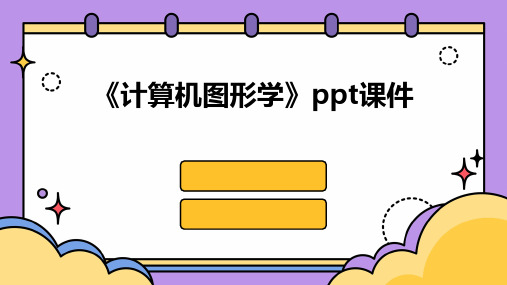
光照模型与阴影生成算法的应用广泛,例如在游戏开发、虚拟现实和 电影制作等领域。
纹理映射算法
纹理映射算法用于将图像或纹理贴图映射到三维物体 的表面。
输标02入题
常用的纹理映射算法包括纹理坐标、纹理过滤和纹理 压缩等。
01
03
纹理映射算法的应用广泛,例如在游戏开发、虚拟现 实和数字艺术等领域。
04
工业设计
使用CAD等技术进行产品设计和原型制作 。
游戏开发
创建丰富的游戏场景和角色,提供沉浸式 的游戏体验。
科学可视化
将复杂数据以图形方式呈现,帮助人们理 解和分析数据。
虚拟现实与增强现实
构建虚拟环境,实现人机交互,增强现实 感知。
02
计算机图形学基础知识
图像与图形的关系
图像
由像素组成的二维或三维数据,通常 用于表示真实世界或模拟的视觉信息 。
全息投影技术
总结词
全息投影技术能够实现三维立体显示,为观众提供沉浸式的 观影体验。
详细描述
全息投影技术利用干涉和衍射原理,将三维物体以全息图像 的形式呈现出来,使观众能够从不同角度观察到物体的立体 形态。这种技术将为电影、游戏和其他娱乐领域带来革命性 的变化。
增强现实技术
总结词
增强现实技术能够将虚拟信息与现实世界相结合,提供更加丰富的交互体验。
HSL和HSV模型
基于色调、饱和度和亮度(或 明度)来描述颜色。
RGBA模型
在RGB基础上增加透明度通道 。
图像处理技术
滤波和锐化
通过改变图像的像素值 来减少噪声、突出边缘
或细节。
色彩调整
改变图像中颜色的分布 和强度,以达到特定的
视觉效果。
图像分割
计算机图形学课件
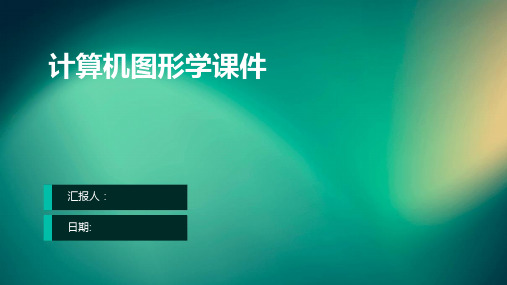
游戏开发中,计算机图形学还涉及实时渲染技术 ,包括OpenGL、DirectX等图形API的使用,以 及GPU加速等技术的应用。
交互体验优化
通过计算机图形学技术,游戏开发者可以优化游 戏的交互体验,例如通过动画、音效等增强游戏 的沉浸感。
影视制作中的计算机图形学应用
01
特效制作
计算机图形学广泛应用于电影、电视剧等影视作品的特效制作中。
1990年代
个人电脑的出现使得计算机图形学进入普 及阶段,各种图形软件和游戏开始广泛使 用。
互联网的出现使得计算机图形学进入新的 发展阶段,网络图像传输和浏览技术得到 了广泛应用。
计算机图形学的应用领域
娱乐产业
电影、电视、游戏等娱乐产业是计算 机图形学的最大应用领域,需要大量 的特效和动画制作。
科学可视化
计算机图形学的发展也将进一步推动艺术 和科技的结合,为艺术家提供更多的创作 工具和展示方式,同时也为科技爱好者提 供更多的探索和创新的空间。
THANKS FOR WATCHING
感谢您的观看
计算机图形学用于生成和操作科学数 据,如气象预报、医学影像、物理模 拟等。
工业设计
计算机图形学可用于产品外观设计、 机械设计等领域,提高设计效率和准 确性。
虚拟现实
计算机图形学生成虚拟环境,提供沉 浸式的体验,广泛应用于教育、培训 、娱乐等领域。
02 计算机图形学基础知识
图像的数字化
图像采样
将连续的图像转换为离散的像素集合
网格建模
使用多边形网格来表示物体的形状,这些多边形可以是由三角形组 成的简单形状,也可以是更复杂的形状。
NURBS建模
使用非均匀有理B样条曲线来表示物体的形状,这些曲线可以创建更 复杂的形状,如自由曲线和曲面。
计算机图形学

当一个纹理被重复使用或者需要填充大范围区域时,使用纹理合成技术。纹理合成通过在 原有纹理上采样并重复排列,生成一个新的纹理。
透明度与alpha混合技术
透明度与alpha 混合技术
在计算机图形学中,透明度 和alpha混合技术用于模拟 光线穿过透明物体时的效果 。
alpha值
alpha值用于描述像素的透 明度,0表示完全透明,1表 示完全不透明。alpha混合 通过将两个像素的alpha值 相乘,得到最终的像素颜色 。
图像文件格式
JPEG
PNG
JPEG是一种常见的有损压缩格式,适用于 照片和真实感图像。
PNG是一种无损压缩格式,支持透明度, 适用于需要保留细节的图像。
GIF
BMP
GIF是一种支持动画和透明度的格式,适用 于需要动态效果的图像。
BMP是一种位图格式,适用于未经压缩的 图像存储和编辑。
图形界面与用户交互
粒子系统是一种模拟不规则形 状、运动和变化的技术,常用 于模拟火、水、烟雾等效果。
02
粒子属性
03
粒子生成
每个粒子具有位置、速度、生 命周期等属性,这些属性可以 控制粒子的运动和变化。
粒子生成是粒子系统的核心, 通过随机生成大量粒子并赋予 它们初始属性,模拟自然现象 。
04
粒子渲染
为了使粒子更加逼真,需要使 用渲染技术对粒子进行着色和 光照处理。常用的渲染技术包 括粒子贴图、粒子光照和粒子 特效等。
02
非均匀有理B样条( NURBS)
掌握NURBS的概念和原理,以及如何 实现。
03
曲面绘制
理解曲面绘制的基本原理,如网格曲 面和参数曲面,并知道如何实现。
光照与阴影技术
计算机图形学概述分析课件

电影特效中的计算机图形学
3D建模与贴图
利用计算机图形学,电影制作人员可以 创建逼真的3D场景和角色模型,为电 影添加视觉效果。
合成与渲染
利用计算机图形学技术,电影中的多 个特效和场景可以合成在一起,并通
过渲染得到最终的视觉效果。
特效制作
通过计算机图形学,电影中的特效如 火、水、烟雾等得以实现,增强电影 的视觉冲击力。
计算机图形学概述分析 课件
目录
Contents
• 计算机图形学简介 • 计算机图形学基础知识 • 计算机图形学关键技术 • 计算机图形学应用案例 • 计算机图形学未来发展
01 计算机图形学简介
定义与概念
定义
计算机图形学是研究使用计算机生成 和操作图形的科学。
概念
通过编程技术,将数据转化为图像并 在屏幕上显示。
发展历程
起步阶段
20世纪50年代,计算机图形学开始起步,主要应用于科学可视化 。
发展阶段
20世纪80年代,随着个人电脑的普及,计算机图形学在娱乐、广 告等行业得到广泛应用。
成熟阶段
21世纪初,随着计算机硬件和软件技术的飞速发展,计算机图形 学在电影制作、游戏设计等领域达到高峰。
应用领域
电影与游戏制作
增强。
02 计算机图形学基础知识
图像表示与处理
01
02
03
图像数字化
将连续的图像转换为离散 的像素集合,便于计算机 处理。
图像编码与压缩
通过特定的算法对图像数 据进行压缩,以减少存储 空间和传输时间。
图像增强
通过各种技术改善图像的 视觉效果,如对比度增强 、噪声去除等。
颜色理论与空间
RGB颜色模型
将三维场景转换到二维屏幕上的过程 ,涉及到颜色、光照和纹理等细节的 处理。
计算机图形学完整ppt课件
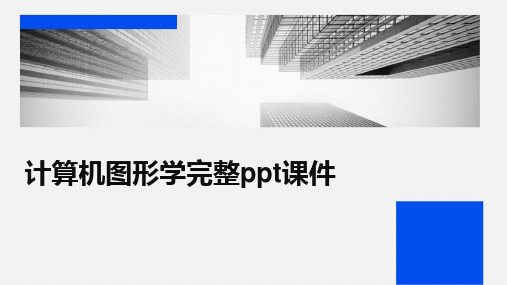
工业设计
利用计算机图形学进行产品设计、仿 真和可视化,提高设计效率和质量。
建筑设计
建筑师使用计算机图形学技术创建三 维模型,进行建筑设计和规划。
计算机图形学的相关学科
计算机科学
计算机图形学是计算机科学的一个重 要分支,涉及计算机算法、数据结构、 操作系统等方面的知识。
物理学
计算机图形学中的很多技术都借鉴了 物理学的原理,如光学、力学等,用 于实现逼真的渲染效果和物理模拟。
02
03
显示器
LCD、LED、OLED等,用 于呈现图形图像。
投影仪
将计算机生成的图像投影 到大屏幕上,用于会议、 教学等场合。
虚拟现实设备
如VR头盔,提供沉浸式的 3D图形体验。
图形输入设备
键盘和鼠标
最基本的图形输入设备,用于操 作图形界面和输入命令。
触摸屏
通过触摸操作输入图形指令,常 见于智能手机和平板电脑。
多边形裁剪算法
文字裁剪算法
判断一个多边形是否与另一个多边形相交, 如果相交则求出交集部分并保留。
针对文字的特殊性质,采用特殊的裁剪算法 进行处理,以保证文字的完整性和可读性。
05
光照模型与表面绘制
光照模型概述
光照模型是计算机图形学中用于模拟光线与物体表面交互的数学模型。
光照模型能够模拟光线在物体表面的反射、折射、阴影等效果,从而增强图形的真 实感。
二维纹理映射原理
根据物体表面的顶点坐标和纹理坐标,计算出每个像素点对应的纹 理坐标,从而确定像素点的颜色值。
二维纹理映射实现方法
使用OpenGL中的纹理映射函数,将纹理图像映射到物体表面。
三维纹理映射技术
三维纹理坐标
定义在三维空间中的坐标,表示纹理图像上的位置。
高级计算机图形学ACG06
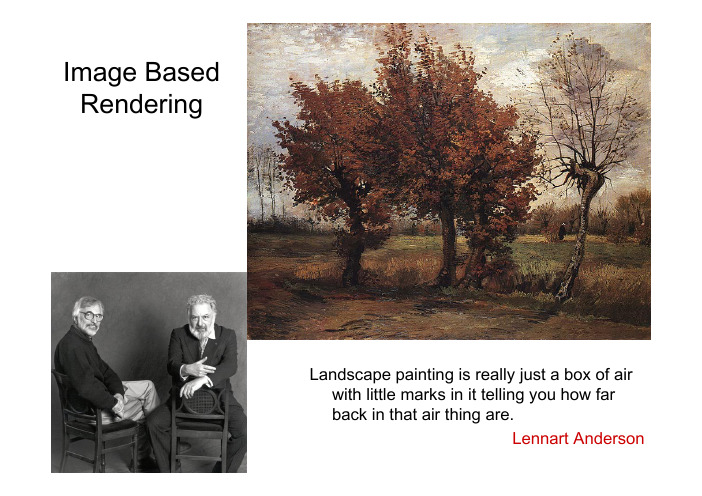
Image BasedRenderingLandscape painting is really just a box of airwith little marks in it telling you how farback in that air thing are.Lennart AndersonOverview•Image based rendering–A paradigm of its own during the last decade–Advantages•rendering is proportional to the number of pixels –not the number of verticesImage based rendering•Commonly used techniques–Sprites, Billboards, Impostors–Lensflares and particle system–Full screen and environmental image based method –Volume renderingRendering spectrum•An important principle of real time–Pre-compute whenever possible–IBR•Reusing a computed image over a series of frames•Represent object with an image–Less expensive–Can be sent quickly to the screenSprite•Sprite–An image that moves around on the screen–e.g. mouse cursor–Sprite can be seen as a texture on a polygonsprite screen pixel–Animation•displaying a succession of different sprites –Viewer see object from different viewpoints•different sprites can be used to represent themSprites• A scene–A series of layers, like 2D cel animations –Each sprites layer has a depth associated –Render in a back to front orderSprites•Sprites–Objects are rendered into sprite layer–Layers are composited on the screen–Each layers are managed independently•The idea–Each sprite can be formed and reused for several frames –Warping and redisplaying an image is considerably simpler than resending an object’s whole set of polygons for eachframe.Sprites•Problems–Object appearance change with view moves–Regenerate the sprite layer•Determine when to warp and when to regenerateOverview of algorithm•There is no correct way to render a scene.–Each render method is an approximation of reality–Photorealism is the goal•Pure image layer rendering depends on:–fast, high quality image warping–filtering–compositing•Image based method can be combined with polygon-based renderingQuickTime VR and the LumigraphA panorama of the Mission DoloresLumigraph and light field• Lumigraph and light field – a single object is viewed from a set of view points • Complex Problem – Perform an interpolation process between stored views in order to create the new view • Much higher data requirements – A tantalizing aspect • Ability to capture the real object and redisplay from any angleBillboardingBillboarding• Billboarding – Orienting the polygon based on the view direction – Combined with alpha texturing and animation to represent many phenomena • Smoke, fire, fog, explosion, energy shield, vapor trails and cloudsBillboarding• A billboard is extreme LOD – reducing all the geometry to one or more textured polygons – The geometry is replaced by an image in the form of a textureBillboarding• Polygon orientation – Surface normal and an up direction – An anchor location • Center of quadrilateral – establish its position in spacer=u×n u nBillboarding• Main task – Decide what surface normal and up vector is used to define the billboard’s orientationScreen aligned billboard• Screen aligned billboard – Similar to 2D sprite – Image is always parallel to the screen • Surface normal – Negation of the view plane’s normal • Up vector – the camera‘s u direction – Useful for information such as annotation textWorld orientated billboard• If the sprite represents a physical object, it is often oriented with respect to the world’s up direction, not the camera’s.•Normal– Negation of the view pane normal• Up vector– Derived from the world ‘s up vector• Projection warps objects that are away from the view direction axis– Not error – Looks fine if a real viewer’s eye are the proper distance and location from the screenview plane alignmentview point orientedTwo real spheresViewpoint oriented billboard•The desired normal–the vector from the center of billboard to the viewer’s positionBillboarding•Billboards’applications–Convincing flames, smoke and explosions by clustering and overlapping animated sprites in a random and chaotic fashionCloud rendering•Gardner’s method–Sets of nested ellipsoids that become more transparent around the viewing opacityAxial billboard•Axial billboard–Allow to rotate around some fixed world space axis and align itself–face the viewer as much as possible within this range •Billboarding technique is commonly used for displaying treesTree model make of 20610 triangles Tree modeled with 78billboardsOverlapping billboardsAxial billboard•Problem–If the viewer flies over the trees and looks straight down –The illusion is ruinedBillboad example •Screen aligned billboard–sphere•Axial billboard–cylinderImpostors•Impostor–Rendering a complex object from the current viewpoint into an image•texture mapped onto a billboard–Rendering is proportional to the number of pixels the impostor covers on screen, not number of vertices–Used for a few instances of the object or a few frames to geta speedup•Collection of small static object•Rendering distant objectsImpostorThe size of impostor is the smallest rectangle containing the projected bounding box of the object View point oriented billboardImpostorsAngle of pixel Angle of texelWhen β scr < βtex , there is a possibility that the texels will be clearly visible, and the impostor has to be regeneratedobjsize texres = screenres 2idis tan cei tan( fov / 2)fov/screenresImpostors• Whether the impostors are valid from the current point of viewRegenerated whenβ scr < βtrans , β scr < β sizeImpostors in games• • • Practical methods for using impostors in games Some heuristic is used to update the texture coordinates When impostors are used for dynamic objectsΔ = d / frames– The largest distance threshold d, divide by the number of time step in the animation – If Update impostor Δin > d – Update the object close to near plane or the mouse cursor move often – However, unpredictable ones such as playersA Simple, Efficient Method for Realistic Animation of CloudsYoshinori Dobashi et al SIGGRAPH00• Clouds – 3D object • e. g. – When Plane is seen flying into a cloud – Impostor is split into two pieces • One behind and one in frontClouds rendered with a set world oriented impostors Clouds in the distance are rendered with skyboxLens flare and bloom• Lens flare – Caused by the lens of the eye or camera when directed at bright light – Halo and ciliary corona – associated with brightnessLens flare, star glare, and bloom effects, along with depth of field and motion blur.High-dynamic range tone mapping and bloomLens flare and bloom• Using a set of textures for the glare effects – Each texture is applied to a square that facing the viewer • An alpha map – Determine how much of the square to blend into the scene • Lens flare change with the position of the light source – A set of squares with different texturesA lens flare and its constituent texturesTwo sparkle textures (Images from a Microsoft DirectX6 SDK program)A halo and a bloomParticle system•Particle system–A set of separate small objectsthat are set into motion usingsome algorithms–Fire, smoke, explosion, waterflows, whirling galaxies–Not rendering, but a method ofanimation–Creating, moving, changing,and delete particles duringlifetimeParticle system–Representation•Points or lines•Position to orient it–Implementation•Pixel shader–Line segment from particle previous position to currentpositions•DirectX–Point sprite primitives–not to send down an entirequadrilateral for each pointFireworks •The simulation of fireworks–the start phase•almost the same coordinates for allthe particles•The speed is determined by theinitial speed reduced by theinfluence of gravity–the rocket explodes•additionally to the original verticaland horizontal speed components,each particle gets one speedcomponent which is directed awayfrom the explosion.Particle structuretypedef struct{float lifetime; // total lifetime of the particle float decay; // decay speed of the particle float r,g,b; // color values of the particle float xpos,ypos,zpos; // position of the particle float xspeed,yspeed,zspeed; // speed of the particle boolean active; // is particle active or not?} PARTICLE;Particle system•Firework–using a single screen aligned, alphatextured billboard for each particle–Varied in size and shape over time/~lswu/homepage/coursework/Fountain/~lswu/homepage/coursework/Depth sprites•Depth sprites or nail-board–Texture image is an RGB image augmented witha ∆parameter for each pixel–Depth deviation from the depth sprite polygon tothe correct depth of the geometryimpostors –Localized depth information–RGB ∆–Imposter•1 bit alpha value for transparency–Delta value•2-16bits•Represent full transparencytwo bits ∆8 bits ∆Depth spritesEach sphere is rendered asWire frame to the scene one textured quadrilateral with depth。
计算机图形学PPT课件

三维图形投影方法
正投影
平行光线垂直投射到投影面上 ,形成物体的正投影。
斜投影
平行光线与投影面成一定角度 投射,形成物体的斜投影。
透视投影
从视点出发,通过透视变换将 三维物体投影到二维平面上。
阴影生成
根据光源位置和物体形状,计 算阴影的位置和形状。
05
真实感图形绘制技术
Chapter
消隐技术
消隐算法分类
计算机图形学PPT课件
目录
• 引言 • 图形系统基础 • 基本图形生成算法 • 三维图形变换与观察 • 真实感图形绘制技术 • 曲线与曲面绘制技术 • 计算机动画技术 • 计算机图形学前沿技术
01
引言
Chapter
计算机图形学概述
01
02
03
计算机图形学定义
研究计算机生成、处理和 显示图形的一门科学。
平移变换 旋转变换 缩放变换 镜像变换
将三维图形沿x、y、z方向移动一 定距离,不改变图形形状和大小 。
在x、y、z方向分别进行缩放,可 改变图形的大小和形状。
三维图形复合变换
变换顺序
先进行缩放、旋转,再进行平移,注意变换顺序对结果的影响。
变换矩阵
将各种基本变换表示为矩阵形式,便于进行复合变换的计算。
医学诊断
通过计算机图形学技术,医生可以更 直观地了解病人病情,进行更准确的 诊断和治疗。
军事模拟
计算机图形学在军事模拟和训练中发 挥重要作用,提高训练效果和作战能 力。
THANKS
感谢观看
通过模拟自然现象或物理过程,生成具有真实感的动画效 果。
过程动画制作流程
建立自然现象或物理过程的数学模型,利用计算机图形学 技术模拟模型的运动和变化过程,生成具有真实感的动画 效果。
计算机图形学(真实感图形的显示)课件
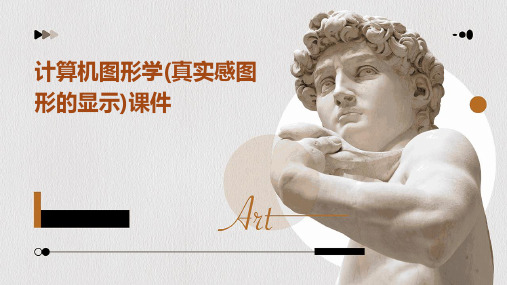
科学家使用计算机图形学来呈现复杂的数据和模拟结果,帮助人们更好地理解科学概念。
科学可视化
02
CHAPTER
真实感图形的显示技术
纹理映射是一种将二维图像映射到三维表面上的技术,以增加物体的表面细节和真实感。
通过纹理映射,可以模拟出物体的表面纹理、质地和图案,如砖块、木材、石材等。
纹理映射还可以用于实现环境贴图、反射贴图等高级效果,以增强场景的真实感。
计算机图形学(真实感图形的显示)课件
目录
计算机图形学简介真实感图形的显示技术3D模型的构建与渲染实时渲染技术未来展望
01
CHAPTER
计算机图形学简介
01
02
03
计算机图形学用于创建逼真的特效和虚拟场景,为电影和游戏提供视觉上的吸引力。
电影和游戏制作
通过计算机图形学,建筑师可以创建三维模型,进行可视化设计和分析。
03
CHAPTER
3D模型的构建与渲染
一款专业的3D建模和渲染软件,广泛应用于游戏开发、电影制作和广告设计等领域。
3D Studio Max
Blender
Maya
开源的3D图形软件,具备建模、动画、渲染和后期制作等功能。
高端的3D动画软件,适用于电影、电视和游戏开发等领域。
03
02
01
定义模型的表面属性,如颜色、光泽度和纹理等。
材质
为模型添加纹理和细节,使其表面更加逼真。
贴图
通过调整材质和贴图的参数,使模型呈现出更加真实的效果。
材质与贴图的结合
骨骼系统
为模型添加骨骼,并设置骨骼的关节和运动范围。
04
CHAPTER
实时渲染技术
实时渲染技术是一种计算机图形学技术,它能够实时生成具有真实感的图形。
高级计算机图形学ACG08
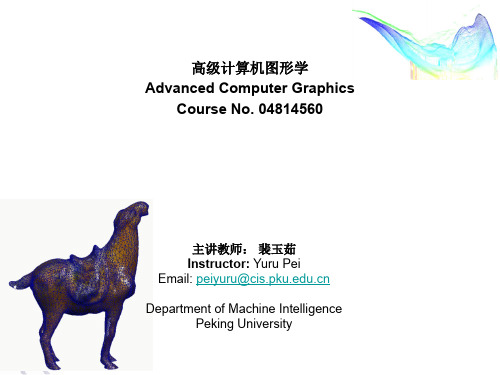
Surface from contours
• Medical studies – biological specimens into thin layers with a microtome – outline of structure of interest – Stack of 2D contours – closed polygon – parallel planes
Sources of 3D Data
• Surface-based modeler – do not have a built-in concept of solidity • other types of modeler – implicit surface creation systems – medical scanning devices – 3 dimensional scanners
Tessellation Consolidation Strips Simplification
Tessellation
• problems of triangulation – a warped quadrilateral • inherent limitation of triangulation, cannot warp any part of an image on a single triangle – Shading problem • colors are different according to the way splitting the quadrilateral
Polygonal Techniques
It is indeed wonderful that so simple a figure as the triangle is so inexhaustible Leopold Crelle
2024版计算机图形学课件ppt课件

01计算机图形学概述Chapter计算机图形学的定义与发展定义发展历程虚拟现实和增强现实VR 图形学来生成和处理三维场景。
工业设计师使用计算机图形学技术来设计和模拟产品的外观和性能。
建筑设计建筑师使用计算机图形学技术来设计和可视化建筑模型。
游戏开发游戏中的场景、角色、特效等都需要计算机图形学的支持。
影视制作都需要用到计算机图形学技术。
计算机科学数学物理艺术02计算机图形学基础Chapter图形与图像的基本概念图形与图像的定义图形是指用矢量方法描述的图像,由几何图元(点、线、面等)组成;图像则是由像素点组成的位图。
图形与图像的区别图形具有矢量特性,可以无限放大而不失真;而图像放大后会失真,因为其由固定数量的像素点组成。
计算机图形学的研究内容研究如何在计算机中表示、生成、处理和显示图形的一门科学。
色彩模型与颜色空间色彩模型01颜色空间02常见的色彩模型与颜色空间031 2 3光栅图形矢量图形光栅图形与矢量图形的比较光栅图形与矢量图形图形显示设备与坐标系统图形显示设备01坐标系统02设备坐标系与逻辑坐标系0303图形生成技术Chapter直线生成算法DDA算法Bresenham算法中点画线法圆生成算法八分法画圆中点画圆法Bresenham画圆法扫描线填充算法边界填充算法洪水填充算法030201多边形填充算法01020304几何变换光照模型投影变换纹理映射三维图形生成技术04图形变换与裁剪技术Chapter01020304将图形在平面上沿某一方向移动一定的距离,不改变图形的大小和形状。
平移变换将图形绕某一点旋转一定的角度,不改变图形的大小和形状。
旋转变换将图形在某一方向上按比例放大或缩小,改变图形的大小但不改变形状。
缩放变换将图形关于某一直线或点进行对称,得到一个新的图形。
对称变换将三维物体在空间中沿某一方向移动一定的距离,不改变物体的大小和形状。
将三维物体绕某一轴旋转一定的角度,不改变物体的大小和形状。
计算机图形学OpenGL(第三版)课件

REPORTING
• 计算机图形学概述 • OpenGL基础知识 • 3D图形绘制 • 动画与交互 • 高级技术与应用 • 案例与实践
目录
PART 01
计算机图形学概述
REPORTING
计算机图形学的定义与分类
计算机图形学是一门研究计算机生成 和操作图形的科学,它通过数学算法 和计算机程序实现二维和三维图形的 生成、渲染和交互。
虚拟现实中的图形渲染技术
3D场景构建
利用OpenGL的3D图形渲染能力,构建逼真的虚拟现实场景,提供 沉浸式的体验。
实时交互与动态渲染
在虚拟现实中实现实时交互,如人物移动、视角变换等,同时根据 用户行为动态调整渲染效果,提高虚拟现实的真实感和沉浸感。
虚拟现实应用开发
结合OpenGL技术,开发各种虚拟现实应用,如虚拟旅游、虚拟展览 、虚拟教育等,拓展虚拟现实技术的应用领域。
OpenGL库(如GLUT或GLEW )。
对于Linux系统,需要安装 OpenGL库(如GLUT或SDL) 和相应的编译器。
开发者还需要了解如何配置项 目以包含OpenGL头文件和链 接OpenGL库。
OpenGL基本操作
01
02
03
04
05
初始化OpenGL 上下文
绘制基本图形
变换和投影
光照和材质
纹理映射
创建窗口,设置窗口回调 函数,创建渲染上下文等 。
使用OpenGL提供的函数绘 制点、线、多边形等基本 图形。
理解并使用平移、旋转、 缩放等变换以及投影矩阵 。
设置光源、材质属性以及 光照模型。
加载和绑定纹理,对几何 图形进行纹理映射。
计算机图形学知识要点课件

Unity
一款跨平台的游戏开发引 擎,支持实时3D渲染和物 理模拟等功能。
图形硬件加速技术
DirectX
微软开发的图形应用程序编程接口,用于加速三维图形渲染和音 频处理等功能。
OpenGL
跨平台的图形应用程序编程接口,提供了一套标准的绘图函数接口 ,支持多种操作系统和硬件平台。
Vulkan
新一代的跨平台图形应用程序编程接口,旨在提供高性能的图形渲 染和并行计算能力。
06
案例分析
游戏中的计算机图形学应用
游戏画面渲染
计算机图形学技术用于实现游戏 中的画面渲染,包括光照计算、 纹理映射、阴影处理等,以提供
逼真的视觉效果。
角色与场景建模
利用三维建模技术,创建游戏中的 角色和场景,通过骨骼动画等技术 实现角色的动态效果。
游戏物理引擎
基于物理模拟的计算机图形学技术 ,用于实现游戏中的物理效果,如 碰撞检测、物体运动轨迹等。
03
高级技术
纹理映射
纹理映射是一种将图像或纹理贴图应用到三维模型表面的技术。通过纹理映射, 可以在不改变模型几何形状的情况下,为其添加更丰富的细节和质感,从而提高 模型的视觉效果。
纹理映射的关键技术包括纹理坐标、纹理采样、纹理过滤和纹理合成等。纹理坐 标用于确定纹理在模型表面的位置,纹理采样用于从纹理图像中获取颜色信息, 纹理过滤用于平滑颜色过渡和减少纹理细节的失真,而纹理合成则可以创建新的 纹理。
准确性。
04
图形硬件与软件
GPU的工作原理
渲染管线
GPU的渲染管线包括顶点着色器、几何着 色器、光栅化、片段着色器和输出合并等 阶段,用于将三维场景转换为二维图像。
纹理采样器
纹理采样器用于从纹理中采样像素颜色, 并将其应用到几何形状上,以实现纹理贴
计算机图形学基本知识PPT课件
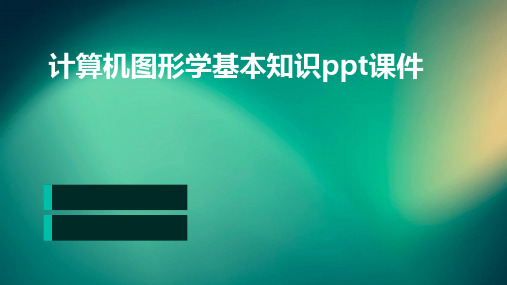
通过仿射变换矩阵对图像进行变换,可以处理更复杂的几何变换。
04 计算机图形学高级技术
光照模型与材质贴图
光照模型
描述物体表面如何反射光线的数 学模型,包括漫反射、镜面反射 和环境光等。
材质贴图
通过贴图技术将纹理映射到物体 表面,增强物体的真实感和细节 表现。
纹理映射
纹理映射技术
将图像或纹理图案映射到三维物体表 面,增强物体的表面细节和质感。
总结
计算机图形学在游戏设计、电影与动 画制作、虚拟现实与仿真等领域有着 广泛的应用。
计算机图形学的发展历程
起步阶段
20世纪50年代,计算机图形 学开始起步,主要应用于几 何形状的生成和简单图形的 处理。
发展阶段
20世纪80年代,随着计算机 性能的提高,计算机图形学 开始广泛应用于电影、游戏 等领域。
总结
计算机图形学利用计算机 技术生成、处理和显示图 形,实现真实世界的模拟 和再现。
计算机图形学的应用领域
游戏设计
游戏中的角色、场景和特效都需要用 到计算机图形学技术。
电影与动画制作
电影特效、角色建模和动画制作都离 不开计算机图形学。
虚拟现实与仿真
虚拟现实技术、军事仿真、工业设计 等领域都广泛应用计算机图形学。
向量图
向量图是矢量图的一种,通常用于描 述二维图形,如几何图形和图表。
图像的分辨率与质量
分辨率
分辨率是指图像中像素的数量, 通常以像素每英寸(PPI)或像素
每厘米(PPC)为单位。
质量
图像质量取决于分辨率、颜色深度 和压缩等因素。
压缩
图像压缩是一种减少图像文件大小 的方法,常见的图像压缩格式有 JPEG和PNG等。
05 C3 计算机图形学基础.ppt共32页PPT资料
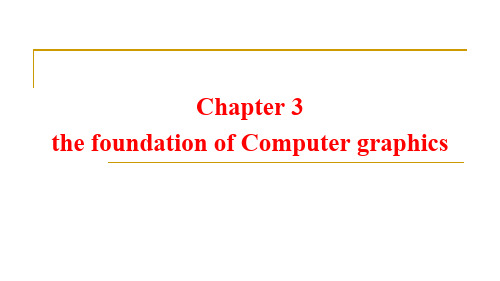
控制点移动时只会影响部分的曲线.
其次数与控制点数目无关,可由使用者任意选择,B-spline比 Bezier有更多的弹性
2019/10/22
上理机械 吴恩启
15
B样条曲线
数学表达:
可进行局部修改,曲线更逼近特征多边形,曲线的阶次和特 征多边形的顶点无关。
5.Transform of 3D graphics
6.Projection transform of 3D graphics
7.Free form curve and surface
2019/10/22
上理机械 吴恩启
2
3.7 free-form curve and surface
自由曲线和自由曲面:
上理机械 吴恩启
10
Hermite曲线
Hermite曲线又称为Ferguson曲线 在早期的曲面设计中得到了应用。但它有许多缺点:
设计条件与曲线始末两点的切矢大小和方向有关,设计 时不易控制;
如果定义高次 Ferguson曲线,需要用到曲线始末两点的 高阶导数。
为此人们在Ferguson数学模型上作了一些改进,得到另外 形式的曲线。 Bezier曲线就是其中一种
2019/10/22
上理机械 吴恩启
18
3.7 free-form curve and surface
曲线生成与编辑-以sw为例
草图中的样条曲线(SPLINE) 投影曲线、分割曲线、螺旋线与涡状线、组合曲线
曲面生成和编辑-以sw为例
拉伸、旋转、扫描、放样、延展、(网格、点云拟合) 圆角、等距、延伸、剪裁、填充、缝合、移动/复制/删
计算机图形学课件

具体操作
裁剪和交叠的实现需要用到裁剪面和 视景体等概念,裁剪面是指与图形相 交的面,视景体是指观察者所能看到 的区域。在进行裁剪时,需要判断图 形的各个部分是否在裁剪面内,并根 据情况对图形进行裁剪;在进行交叠 时,需要将图形按照一定的顺序排列 ,以避免重叠遮挡。
应用
裁剪和交叠广泛应用于计算机图形学 中的图形绘制和渲染等领域,它们能 够提高绘制的效率和效果。
04
计算机图形学高级技术
真实感图形渲染
总结词
通过复杂的算法和计算,将图形渲染为具有高度真实感的图像。
详细描述
真实感图形渲染技术包括对光线的模拟、阴影的处理、反射和折射的效果等 ,以产生具有真实感的图像。
纹理映射和环境贴图
总结词
将纹理和环境贴图映射到三维模型上,增加模型的细节和视觉效果。
详细描述
个基本属性。
光照和阴影
环境光
来自周围环境的均匀照射光。
点光源
从一个点发出的光,可以产生阴影效果。
方向光
纹理映射
来自一个特定方向的光,可以产生阴影效果 。
将纹理图像映射到三维模型表面,增加视觉 效果的真实感。
纹理和材质
纹理贴图
将纹理图像映射到三维模型表面,增加视 觉效果的真实感。
纹理坐标
指定纹理贴图在三维模型表面的位置和方 向。
分类
视图变换分为固定视角和自由视 角两种,固定视角是指观察者视 角固定,只能观察到场景的某一 个固定方向,而自由视角则允许 观察者在场景中自由移动,观察 到场景的任意方向。
应用
视图变换广泛应用于三维游戏、 虚拟现实等领域,它能够提供更 加真实的观察体验。
裁剪和交叠
定义
裁剪是指在绘制图形时,将图形的一 部分隐藏在视景体之外,以避免不必 要的绘制;交叠是指在绘制多个图形 时,将它们按照一定的顺序排列,以 避免重叠遮挡。
- 1、下载文档前请自行甄别文档内容的完整性,平台不提供额外的编辑、内容补充、找答案等附加服务。
- 2、"仅部分预览"的文档,不可在线预览部分如存在完整性等问题,可反馈申请退款(可完整预览的文档不适用该条件!)。
- 3、如文档侵犯您的权益,请联系客服反馈,我们会尽快为您处理(人工客服工作时间:9:00-18:30)。
高级计算机图形学Advanced Computer Graphics Advanced Computer Graphics Course No. 04814560主讲教师:裴玉茹Instructor: Yuru PeiEmail: peiyuru@ Email:peiyuru@cis pku edu cn Department of Machine IntelligencePeking UniversityPeking UniversityNon-PhotorealisticRendering/~hxu/publications/index.htmlUsing a term like ‘nonlinear science’ is likereferring to the bulk of zoology as ‘the studyof nonelephant animals.of nonelephant animals’-Stanislaw UlamNPR’s applications NPR s applicationsNPR s applications NPR’s applicationsOutline •Toon Shading(painting)•Silhouette Edgeg(g)Rendering(Inking)•Other Styles•LinesT Sh diToon Shading •Toon Shading(celshading)–The most popularform of NPR–Amplification“Amplificationthroughsimplification”-UnderstandingComics, McCloudg•How to do toon shading?–Painting& inking(shading&silhouette rendering)silhouette renderingMost common methods for paintingSolid color Two-tone approach (hard shading)Gouraud-shaded duck silhouettes rendered,two tone shading specular/diffusewith solid shading two-tone shading specular/diffuse three-toneN li hti d l(t b d)New lighting model (tone-based)•Traditional shadingTraditional shading•Tone-based shadingNew lighting model (tone-based) N li hti d l(t b d)New lighting model (tone-based)Black shaded regions hide details & some edge linesHighlight and fine detail are lost in white shaded regionsN li hti d l(t b d)New lighting model (tone-based) Colored Phong-shaded spheres with edge lines and highlightsC l d Ph h d d h ith d li d hi hli htColored spheres shaded with hue and luminance shift, including edge lines and highlightslines and highlightsg pShading method-1D texture map •Lake et al. and Lander’s shading methoduse the idea of computing the diffuse shading dot product –use the idea of computing the diffuse shading dot product n•L –for each vertex and using n•L as a texture coordinate to access a 1D texture map pg pShading method-1D texture map •Cartoon shadingSilh tt d i(I ki)Silhouette rendering (Inking)•Different types of edgesDifferent types of edges–boundary or border edge•Edges not shared by two polygonsEdges not shared by two polygons–crease or hard edge•The dihedral angle is greater than somethreshold•Further subcategorized into ridge & valley –material edget i l d•The two triangles sharing it differ in material –silhouette edgesilhouette edge•One triangle is front-face, and the other isback-faceSilh tt d i(I ki)Silhouette rendering (Inking)•Methods used can be roughly categorized as based on Methods used can be roughly categorized as based on Surface angle–Surface angle–Procedural geometry–Image processing–HybridSurface angleg•Similar to the idea of Lake for shading–Use dot product between the direction to the viewpoint and the Use dot product between the direction to the viewpoint and thesurface normal•Environment Map p•1D texture (in practice)Surface angle •Advantage–Extremely fast•Disadvantage–Only work for some models•For a model such as cube, it fails.–The silhouette lines are drawn with variable widthProcedural geometryProcedural geometry•Basic idea:–Render the front faces normally, then render the back faces in a Render the front faces normally then render the back faces in a way as to silhouette edges visible.•Thick lines–Draw only the edges of theback facesb k fNehe productions : Lesson 37p/Procedural geometryProcedural geometry•Z-bias–Move the backfaces forward in screen Z by biasing themf f•Fixed amount•k z where z is the average distance from polygon tok*z where z is the average distance from polygon tocamera and k is constant•Use API such as glPolygonOffset()g yg()–Render the backfaces themselves in blackProcedural geometryProcedural geometry•Fattened triangle–Fatten the backfacesf•Pushing outward each edge by a distance proportional toz/(v Nz/(v•N)B–Render the backfaces themselves in blackProcedural geometryProcedural geometry•Fattened triangle–make the resulting edge the same thickness in screen spaceResults WireframeTranslation Fattening40 fps 50 fps 11.5 fpsThick lines Z bias Fattened trianglesProcedural geometryP d l t•shell or halo methodshell or halo method–Shifting normal by an amount proportional to their z-distance from the eyethe eyeg g p •Moving vertices outwards along their normals is a perfect task for a vertex shader–Without any help from the CPUProcedural geometryProcedural geometry•shell or halo methodshell or halo method–Simple to implement, efficient, robust, and gives steady performancep–Used by the game Cel DamageP d l tProcedural geometry•Curved surface generated by the acceleratorCurved surface generated by the accelerator•Fattening method–can’t•Shell method–can work as long as the representation can be displacedoutwards along the surface normaloutwards along the surface normal•Z-bias method–works with all curved surfaces•Limitations–Limited control over the edge appearanceLimited control over the edge appearance–Semi-transparent surface–Need antialiasing gProcedural geometryProcedural geometry•Ridge edges [Raskar01]Rid d–To generate an additional polygon along each edge ofthe triangle being renderedthe triangle being rendered–These edge polygons are bent away from thetriangle’s plane by the user-defined critical dihedralangle.–Valley edges, this tech. can be performed by using the stencil buffer and up to 3 passesstencil buffer and up to3passesImage processing•Image-based method–Operates entirely on data stored in buffers and does not Operates entirely on data stored in buffers and does notmodify (or even know about) the geometry in the scene•Z-buffer•Normal bufferImage processingImage processingNormal maps depth mapsImage processingI i•Mitchell, Image processing with pixel shaders in Direct3D Mitchell“Image processing with pixel shaders in Direct3D”–Using version 1.4ppixel shaders–Sample texture 6 timesin a single passS–Implement a Sobel edgedetection filterImage processingI i•Advantages–Handle all primitives, even curved surfacesMeshes do not have to be connected or even consistent –Meshes do not have to be connected or even consistent •Disadvantages–Needing powerful pixel shader–Some silhouette edge can be missed•E. g. a sheet of paper on a desk•Solution : object ID–Still can’t deal with paper folded onto itselfSilhouetteEdge DetectionSilhouette Edge DetectionB t f•Brute force–Loop through all the edgesSpeed-up:–Speed-up :•Cull out edges inside planar polygons •Edge bufferg–Store two additional bits per edge (F and B)•Loop through all faces, determine whether theyf t b k f th XOR th ti F B 10are front or back face, then XOR the respective bits of the adjacent edges.•the FB bits are11->silhouette 01the FB bits are 11 silhouette–Could use only one bit (if no boundary edges)•XOR in 0 for frontfacing and 1 for backfacing •If the edge is silhouette, the bit is 1Silh tt Ed D t tiSilhouette Edge Detection •Stochastic methodStochastic methodSilhouette Edge DetectionSilh tt Ed D t ti •Gauss mapsGauss maps–Precomputation methodface normal a point on the Gaussian sphere•face normal->a point on the Gaussian sphere•mesh edge -> an arc on the Gaussian sphereEdgeNormal 2 Normal 1Silh tt Ed D t tiSilhouette Edge Detection•Gauss mapsGauss maps–For orthogonal projectiona view of the scene a plane through the origin of the•a view of the scene->a plane through the origin of theGaussian sphere•Every arc intersected by this plane is a silhouette edge –No need to check if the face is front or back facing for each frameHybrid SilhouettingH b id Silh tti•Use both image and geometric elementsUse both image and geometric elements–4 stepsStep 1: finds a list of silhouette edges•Step1:finds a list of silhouette edges•Step 2: render all the object’s triangles and silhouetteedges, assigning each a unique ID number•Step 3: the ID buffer is read back and extract the visiblesilhouette edges to form smooth stroke paths•Step 4: render stylized strokes along these reconstructedStep4:render stylized strokes along these reconstructedpathsH b id Silh ttiHybrid Silhouetting•The strokes themselves can be stylized in many different ways The strokes themselves can be stylized in many different waysOther StylesStylized rendering techniqueStylized rendering technique•Pencil sketch shading–Extend 1D texture method–Instead of selecting texels, uses L▪n to select a texture of appropriate densityappropriate density•The textures are crated by randomly selecting from thepencil strokes and placing them on the texture with randomspacing to avid coherence–If a Polygon requires more than one texture•Split the polygonSplit the polygonStylized rendering techniqueStylized rendering technique–The texture is applied with screen space coordinates to give a hand drawn lookhand-drawn look•Problem: as objects are animated, they “swim”through the textureStylized rendering technique Stylized rendering techniqueStroke texturesOther Styless c a l e←tone →←→Real-Time HatchingReal-Time Hatching•Maintaining both spatial and temporal coherence–Temporal: Tonal Art Maps (TAMS)•Automatic generationR d l l d did t t k d l t th–Randomly-placed candidate strokes and select the“best-fitting”。
